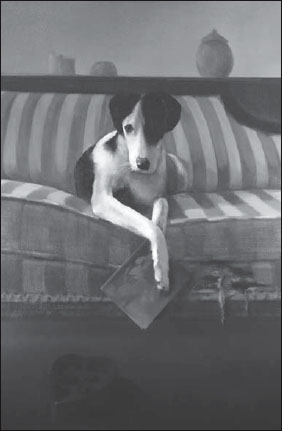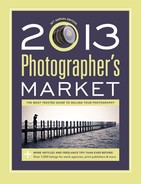GRANTING
YOUR WISH
Enhance Your Résumé
and Secure Funding
Even under the best economic conditions, the art market can be fickle. Today the economy is in dire straights. Therefore, you need to think outside the box to develop creative ways to introduce your work to the art-buying community. One pathway that’s often overlooked is grant support. Actively seeking grant support is common practice in other disciplines, such as biology. However, photographers are surprised sometimes to learn that similar programs are available for them. Many photographers are equally unaware of the career benefits that winning a grant can have. A grant can provide help for you to focus on a favorite theme and can lead to publicity for your work in the local press and TV, as well as in social media channels like Facebook and Twitter. Listing an award on your curriculum vitae adds considerable weight to your accomplishments as well.
Learn the difference
Both public and private grant programs are available to fund creative and artistic activities. The requirements and qualifications for applicants will vary for each program. Grant awards generally fall into two areas. The first of these is fellowships. A fellowship provides direct financial support to a photographer, and the award is often based on the photographer’s past record of achievement. The goal of a fellowship is to provide a stipend, freeing the photographer for creative activities. The second area is grants. A grant is typically designed to fund a specific project. These awards are often confined to the direct costs for the project, although they may provide salary support.

My Secret Valentine (oil, 36×24) is one of the six paintings from JoEllen Reinhardt’s project celebrating the history of Worcester, Massachusetts. This piece commemorates Esther Howland, who in 1879 founded the New England Valentine Company and sold her cards in her father’s Worcester stationery store. (For this painting, Reinhardt painted her dog Myles—a Puerto Rican Sato Rescue dog—holding a valentine.)
Check out regional programs
There are state, national and international programs that support the visual arts; however, there are also many regional programs designed to assist local artists within the communities they serve. “Spending a day on the Web is a great place to start to find programs,” says Deborah McNamara, vice-chair of the Worcester Arts Council (WAC) in Massachusetts. An agent of the Massachusetts Cultural Council, which receives funding primarily from the Massachusetts Legislature and the National Endowment for the Arts, WAC distributes approximately $75,000 to Worcester-based artists in the form of two fellowships and approximately thirty grant applications each year. There are 328 additional councils servicing all 351 Massachusetts cities and towns. “WAC’s website provides current information for potential applicants. We strongly encourage artists to review all posted material and call or e-mail with their questions,” says McNamara.
One grant recipient’s story
A recent recipient of a WAC grant is JoEllen Reinhardt (www.joellenreinhardt.com). A Worcester native, Reinhardt applied for and received a small grant from WAC to support the development of six separate paintings, each relating to a specific person, company or product that has made a difference in the history of Worcester, Massachusetts. The grant was for $1,000, which helped to pay for general supplies for the project. “I’ve always been impressed with the many events of cultural and historical significance that have occurred in Worcester, my hometown,” says Reinhardt when asked about her project. “The WAC award provided the incentive to develop a project I’d always planned to do at some point in time.”
12 TIPS FOR GETTING A GRANT
1. Search online for opportunities. The Internet provides a wealth of information (see Other Resources sidebar).
2. Network with members of local art associations, such as city arts councils, and sign up to receive the clubs’ newsletters.
3. Be conscious of the application deadline. The application process will take time, so start preparing early.
4. Be wary of application fees. Most legitimate groups that distribute grants and fellowships are nonprofit organizations and don’t require fees for applicants.
5. Many programs are theme-based; therefore, your application should directly address the theme.
6. Understand all budget restrictions. For example, if the granting organization is unable to provide support for capital equipment, your budget cannot include funding to buy a camera.
7. Like the project you’re proposing. Only apply to a fellowship or propose a project that you’re actually interested in doing.
8. Most programs have specific requirements for applications, so make certain you understand them. For example, if you’re not a sculptor, applying for a fellowship to support sculptors is not for you.
9. Follow the proposal submission directions meticulously, with attention to page limitations, font size, spacing, number of copies, and so forth.
10. Be professional. Proofread your application for typos, misspellings and grammatical errors. If images of your work are required, provide high-quality photographs or digital files.
11. Program themes and qualifications can and often do vary from year to year, so always be certain you have a current grant prospectus.
12. Don’t procrastinate in requesting letters of recommendation: Asking colleagues can be intimidating, but don’t put it off! Writing good letters will take your colleagues some time, so give them ample notice.
The award, which culminated in a public exhibition, generated significant local buzz in the community, including coverage on a local TV show and in newspaper articles. The signature piece of Reinhardt’s show, entitled My Secret Valentine and commemorating Esther Howland, founder of the New England Valentine Company in Worcester, was sold on opening night. There were three portraits in the show; one of them—Smiley Face—depicts Charlie Ball, son of the late Harvey Ball, who is credited with the design of the iconic Smiley Face in 1963. Reinhardt received a portrait commission based upon a referral from someone who attended the show. The client was impressed with Smiley Face and hired Reinhardt to paint a posthumous portrait.
GRANT AND FELLOWSHIP WEBSITES AND NEWSLETTERS
• ArtDeadline.com (artdeadline.com)
• Art Opportunities Monthly (www.artopportunitiesmonthly.com)
• Artist Trust (www.artisttrust.com)
• Creative Capital (www.artistsresourceguide.org/creative_capital_foundation)
• The Foundation Center (foundationcenter.org)
• Foundation Grants & Individuals Online (www.gtionline.fdncenter.org)
• Grants.gov (www.grants.gov/applicants/find_grant_opportunities.jsp)
• Institute of Museum and Library Services (www.imls.gov)
• National Endowment for the Arts (www.nea.gov)
• National Endowment for the Humanities (www.neh.gov)
• National Assembly of State Arts Agencies (www.nasaa-arts.org)
• New York Foundation for the Arts (www.nyfasource.org)
• WomenArts (www.womenarts.org)
“The entire grant experience greatly exceeded my expectations,” says Reinhardt. “I had the privilege to meet some interesting people from Worcester who generously shared their interest and knowledge of the town’s history in preparation for the show. During the opening, small groups would gather around a painting, and people began to share with each other their unique memories or family stories related to the theme of the piece. It was exciting to watch!”
Benefits of winning a grant
For a photographer pursuing a career in higher education, the benefits of grant and fellowship awards are obvious. Because applications often require a carefully written description of the project as well as supporting documents, such as letters of recommendation, the process itself is a demonstration of scholarship. Apart from the money awarded to the grant winner, the benefits to the entire community of photographers are less apparent. Still, because these honors become permanent accolades for a photographer’s résumé, awards also enhance the biography of a career photographer.
BOOKS ON GRANTS
• The Artist’s Guide to Grant Writing by Gigi Rosenberg (Watson-Guptill)
• Guide to Getting Arts Grants by Ellen Liberatori (Allworth Press)
“Fine work will always stand on its own merit; however, artists having notable achievements will often receive a second look from potential buyers, which can lead to a sale,” states Domonic Boreffi, the owner of Gallery Antonia in Chatman, Massachusetts (www.galleryantonia.com), which represents the work of nationally recognized artists, including Reinhardt. “Like juried show credits and art reviews in publications,” says Boreffi, “being a grant recipient communicates that an artist is serious about his career and that his talent has been recognized by his peers. An artist’s record of achievement aids dealers in efforts to promote an artist’s work.”
Advice to grant seekers
When applying for an award, you should note the application deadline and allow yourself plenty of time to prepare. Most programs require a written description of the proposed topic, as well as biographical information and letters of support from other artists and colleagues. As a result, a quality application will take some time to develop. Before starting work on your proposal, make sure you read and understand the program prospectus and the qualifications for applicants.

Reinhardt’s portrait Smiley Face (oil, 20×16) features Charlie Ball, son of Harvey Ball—the gentleman who designed the Smiley Face as a symbol to raise employee morale at the State Mutual Life Assurance Company. As a result of the showing of her six pieces, which included three portraits, Reinhardt received a portrait commission.
Programs are often theme-based, and a competitive application will need to clearly state how the proposed project addresses the theme. Some programs have specific qualifications that an applicant must meet, such as gender, residency status, level of education, and so forth. You should feel free to contact program administrators for answers to specific questions. Most administrators welcome the opportunity to discuss their program and take pride in aiding applicants through the process. If you provide yourself ample time for preparation, applying for grant support can be fun and rewarding.
Christopher Reinhardt is a theoretical physicist, a portrait artist—and husband to the classically trained realist painter and grant winner JoEllen Reinhardt. Learn more about JoEllen’s still life and portrait work at www.joellenreinhardt.com.
Adapted from the January/February 2012 issue of The Artist’s Magazine. Used with the kind permission of The Artist’s Magazine, a publication of F+W Media, Inc. Visit www.artistsnetwork.com to subscribe.
